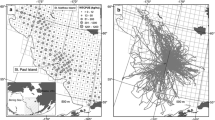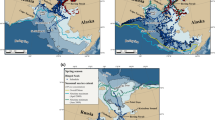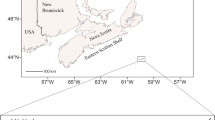Abstract
Movements and behavior of top marine predators are often closely linked with productive oceanic fronts or regional prey aggregations. Consequently, it is of interest to quantify habitat needs and preferences, which can facilitate predictions of conditions favoring persistence and success. Multivariate habitat models of movements and dive behavior of narwhals (Monodon monoceros, Linnaeus) in the eastern Canadian high Arctic and West Greenland were developed using data collected from satellite telemetry studies on three separate sub-populations. Twenty-six narwhals were captured between 1993 and 2000 and fitted with satellite-linked time–depth recorders. Geographic positions of whales at 24-h time steps were linked to dive behavior variables compressed on a daily scale, including numbers of dives to different target depths or durations, time near the surface, daily dive rate, and travel speed. Whale movements and behavior were linked to biophysical variables in a raster format using a GIS (bathymetry, bottom topography, bottom temperature, and distance from the coastline) and analyzed using linear and generalized linear mixed models, accounting for temporal autocorrelation and random variation among individuals. Models suggested that several physical variables described narwhal behavior, predominantly bathymetry and distance from the coastline (particularly deep or long dives). Other descriptor variables, such as size category and sex, also explained portions of the model variability, particularly for shallow dives, surface time, and dive rates. Bottom temperature (°C) was the strongest predictor of all dive behaviors when narwhal location data were restricted to periods with available temperatures. The bottom temperature range and gradient selected by narwhals on their wintering grounds often coincided with areas of concurrent high density of Greenland halibut (Reinhardtius hippoglossoides, Walbaum) and predictable open water in winter pack ice in Baffin Bay. These quantitative habitat models made it possible to reconcile the behavioral traits of narwhals with dynamic environmental factors.




Similar content being viewed by others
References
Arthur SM, Manly BF, McDonald LL, Garner GW (1996) Assessing habitat selection when availability changes. Ecology 77:215–227
Barber DG, Saczuk E, Richard PR (2001) Examination of beluga–habitat relationships through the use of telemetry and a geographic information system. Arctic 54:305–316
Becker BH, Beissinger SR (2003) Scale-dependent habitat selection by a nearshore seabird, the marbled murrelet, in a highly dynamic upwelling system. Mar Ecol Prog Ser 256:243–255
Bowering WR, Brodie WB (1991) Distribution of commercial flatfishes in the Newfoundland–Labrador region of the Canadian Northwest Atlantic and changes in certain biological parameters since exploitation. J Sea Res 27:407–422
Bowering WR, Nedreaas KH (2000) A comparison of Greenland halibut (Reinhardtius hippoglossoides) fisheries and distribution in the Northwest and Northeast Atlantic. Sarsia 85:61–76
Boyce MS, McDonald LL (1999) Relating populations to habitats using resource selection functions. Trends Ecol Evol 14:268–272
Boyd IL, Staniland IJ, Martin AR (2002) Distribution of foraging by female Antarctic fur seals. Mar Ecol Prog Ser 242:285–294
Breslow NE, Clayton DG (1993) Approximate inference in generalized linear mixed models. J Am Stat Assoc 8:9–25
Burns JM, Castellini MA (1998) Dive data from satellite tags and time depth recorders: a comparison in Weddell seal pups. Mar Mamm Sci 14:750–764
Carroll C, Zielinski WJ, Noss RF (1999) Using presence–absence data to build and test spatial habitat models for the fisher in the Klamath region, USA. Conserv Biol 13:1344–1359
Carroll C, Phillips MK, Schumaker NH, Smith DW (2003) Impacts of landscape change on wolf restoration success: planning a reintroduction program based on static and dynamic spatial models. Conserv Biol 17:536–548
Chumakov (1969) The Greenland halibut (Reinhardtius hippoglossoides (Walbaum)) in the Iceland area—the halibut fisheries and tagging. J Ichthyol 9:900–912
Dietz R, Heide-Jørgensen MP, Richard PR, Aquarone M (2001) Summer and fall movements of narwhals (Monodon monoceros) from northeastern Baffin Island towards northern Davis Strait. Arctic 54:244–261
Folkow LP, Blix AS (1999) Diving behavior of hooded seals (Cystophora cristata) in the Greenland and Norwegian Seas. Polar Biol 22:61–74
Frost KJ, Simpkins MA, Lowry LF (2001) Diving behavior of subadult and adult harbor seals in Prince William Sound, Alaska. Mar Mamm Sci 17:813–834
Gregr EJ, Trites AW (2001) Predictions of critical habitat for five whale species in the waters of coastal British Columbia. Can J Fish Aquat Sci 58:1265–1285
Guinet C, Dubroca L, Lea MA, Goldsworthy S, Cherel Y, Duhamel G, Bonadona F, Donnay J-P (2001) Spatial distribution of foraging in female Antarctic fur seals Arctocephalus gazella in relation to oceanographic variables: a scale-dependent approach using geographic information systems. Mar Ecol Prog Ser 219:251–264
Heide-Jørgensen MP, Dietz R (1995) Some characteristics of narwhal, Monodon monoceros, diving behavior in Baffin Bay. Can J Zool 73:2120–2132
Heide-Jørgensen MP, Laidre KL (2004) Declining open water refugia for top predators in Baffin Bay and adjacent waters. Ambio (in press)
Heide-Jørgensen MP, Dietz R, Laidre KL, Richard P (2002) Autumn movements, home range and winter density of narwhals (Monodon monoceros) from Tremblay Sound, Baffin Island. Polar Biol 25:331–341
Heide-Jørgensen MP, Dietz R, Laidre KL, Richard P, Orr J, Schmidt HC (2003) The migratory habits of narwhals. Can J Zool 81:1298–1305
Jørgensen OA (1997) Movement patterns of Greenland halibut, Reinhardtius hippoglossoides (Walbaum) in West Greenland as inferred from trawl survey distribution and size data. J Northwest Atl Fish Sci 21:23–37
Jørgensen OA (1998) Results of the Joint Japan–Greenland Trawl surveys at West Greenland 1987–1995 on Greenland halibut (Reinhardtius hippoglossoides) and roundnose grenadier (Coryphaenoides rupestris). NAFO (Northwest Atl Fish Organ) Sci Counc Stud 31:21–56
Kareiva P, Wennergren U (1995) Connecting landscape patterns to ecosystem and population processes. Nature 373:299–302
Laidre KL (2003) Space use patterns of narwhals in the high Arctic. PhD dissertation, University of Washington, Seattle
Laidre KL, Heide-Jørgensen MP, Dietz R, Hobbs RC, Jørgensen OA (2003) Deep-diving by narwhals, Monodon monoceros: differences in foraging behavior between wintering areas? Mar Ecol Prog Ser 261:269–281
Laidre KL, Heide-Jørgensen MP, Logsdon ML, Hobbs RC, Dietz R, VanBlaricom GR (2004a) Fractal analysis of narwhal space use patterns. Zoology 107:3–11
Laidre KL, Heide-Jørgensen MP, Jørgensen OA, Treble MA (2004b) Deep ocean predation by a high Arctic cetacean. ICES J Mar Sci 61:430–440
Lea M-A, Dubroca L (2003) Fine-scale linkages between the diving behavior of Antarctic fur seals and oceanographic features in the southern Indian Ocean. ICES J Mar Sci 60:990–1002
Loughlin TR, Sterling JT, Merrick RL, Sease JL, York AE (2003) Diving behavior of immature Steller sea lions (Eumetopias jubatus). Fish Bull (Wash DC) 101:566–582
Macdonald DW, Rushton S (2003) Modelling space use and dispersal of mammals in real landscapes: a tool for conservation. J Biogeogr 30:607–620
Matthiopoulos J (2003) The use of space by animals as a function of accessibility and preference. Ecol Model 159:239–268
Riget F, Boje J (1989) Fishery and some biological aspects of Greenland halibut (Reinhardtius hippoglossoides) in West Greenland waters. Northwest Atl Fish Organ Sci Counc Stud 13:41–52
Thompson D, Moss SEW, Lovell P (2003) Foraging behaviour of South American fur seals Arctocephalus australis: extracting fine scale foraging behaviour from satellite tracks. Mar Ecol Prog Ser 260:285–296
Treble MA, Bowering R (2002) The Greenland halibut (Reinhardtius hippoglossoides) fishery in NAFO Division 0A. Northwest Atl Fish Organ SCR Doc 02/46:1–10
Acknowledgements
Narwhal tagging projects were funded by the Greenland Institute of Natural Resources, the National Environmental Research Institute, the Department of Fisheries and Oceans (Canada), the Nunavut Wildlife Research Trust Fund, the Commission for Scientific Research in Greenland, the Danish Natural Research Council (51-00-0131), and the Danish Environmental Protection Agency (as part of DANCEA). The National Marine Mammal Laboratory, the School of Aquatic and Fishery Sciences, University of Washington, and the Washington Cooperative Fish and Wildlife Research Unit, Biological Resources Division, U.S. Geological Survey provided funding for the analysis. Bottom temperature data were obtained from trawl surveys funded by the Danish Environmental Protection Agency, as part of the environmental support program DANCEA (Danish Cooperation for Environment in the Arctic), the Nunavut Wildlife Research Trust Fund, and Fisheries and Oceans Canada. P. Richard and J. Orr assisted both in the field and the office and D. DeMaster, G. VanBlaricom, and two anonymous reviewers improved the manuscript. All work presented here complies with current laws of the country in which they were performed.
Author information
Authors and Affiliations
Corresponding author
Additional information
Communicated by J.P. Grassle, New Brunswick
Rights and permissions
About this article
Cite this article
Laidre, K.L., Heide-Jørgensen, M.P., Logdson, M.L. et al. Seasonal narwhal habitat associations in the high Arctic. Marine Biology 145, 821–831 (2004). https://doi.org/10.1007/s00227-004-1371-1
Received:
Accepted:
Published:
Issue Date:
DOI: https://doi.org/10.1007/s00227-004-1371-1




